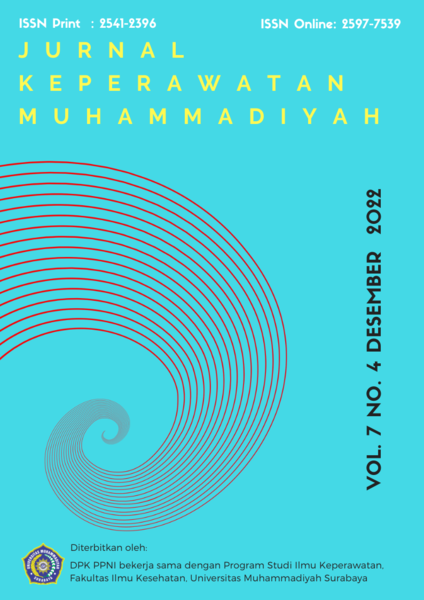Kegawatan Sindrom Geriatri, Self Care Deficit, terhadap Kualitas Hidup Lansia
DOI:
https://doi.org/10.30651/jkm.v7i4.15338Keywords:
Elderly, Geriatric Syndrome Emergency, Self Deficit, Quality of Life,Abstract
Background:Â The proportion of the elderly population increases every year, resulting in a higher life expectancy, but also higher health care. The elderly often experience geriatric emergency syndrome problems so that it is closely related to the independence of the elderly in maintaining their health. Changes in the independence of the elderly bring real changes to the elderly in carrying out daily activities in certain social and cultural conditions where this condition puts the elderly at risk for changes in the quality of life.Objective:Â This study aims to identify the severity of geriatric syndrome, self care deficit on the quality of life of the elderly.Methods:Â This type of research is experimental observation with 100 respondents at UPTD Griya Werdha Jambangan Surabaya.Results:Â The Spearman rank correlation test showed that the severity of the geriatric syndrome was associated with the quality of life in the physical domain (0.011), psychological domain (0.000), and the environmental domain (0.000), while the social relationship domain (0.117) had no relationship with the severity of the geriatric syndrome. Self care deficit with the quality of life of the elderly is related to the psychological domain (0.014), while the physical domain (0.152), social relations (0.932) and the environment (0.227) have no relationship.Conclusion:Â The conclusion of this study is that there is a relationship between the severity of geriatric syndrome and the quality of life of the elderly in the physical, psychological, and environmental domains. There is a relationship between self care deficit with the quality of life of the elderly in the psychological domain.References
Alligood, M. R. (2013). Nursing theory: Ulitization & Application (5 th). Elsevier Inc.
Alligood, M. R. (2014). Pakar Teori Keperawatan (A. Y. Hamid & K. Ibrahim (eds.); 8th ed.). Elsevier (Singapore) Pte Ltd.
BPS. (2021). Statistik Penduduk Lanjut Usia 2021. https://www.bps.go.id
Ginting, R., Onk, S. K., & Kedokteran, F. (2019). COMPREHENSIVE GERIATRIC ASSESSMENT : HORIZON BARU ASPEK RADIOTERAPI PADA PENANGANAN PASIEN KANKER LANJUT USIA.
Heryanah. (2015). Ageing Population dan Bonus Demografi Kedua di Indonesia. Populasi, 23(2), 1–16.
I, M. H. L., Hammerschmidt, N., Carneiro, K., I, M. A. B., I, M. H. W., Maria, T., Ii, L., Iii, J. A., Federal, U., Pós, P. De, & Curitiba, E. (2016). Frailty and quality of life in elderly primary health care users. Rev Bras Enferm [Internet]., 69(3), 478–483. https://doi.org/478 Rev Bras Enferm [Internet]. 2016 mai-jun;69(3):478-83. http://dx.doi.org/10.1590/0034-7167.2016690309i
Id, A. M. S., Morley, J. E., Berg-weger, M., Lundy, J., Little, O., Leonard, K., & Malmstrom, T. K. (2020). High prevalence of geriatric syndromes in older adults. PLoS ONE, 1–12. https://doi.org/10.1371/journal.pone.0233857
Kementrian Kesehatan RI. (2014). Situasi dan Analisis Lanjut Usia. https://pusdatin.kemkes.go.id/
Labra, C. De, Maseda, A., Lorenzo-lópez, L., López-lópez, R., Buján, A., RodrÃguez-villamil, J. L., & Millán-calenti, J. C. (2018). Social factors and quality of life aspects on frailty syndrome in community-dwelling older adults : the VERISAÚDE study. BMC Geriatrics, 18(66), 1–9. https://doi.org/https://doi.org/10.1186/s12877-018-0757-8 RESEARCH
Mauceri, M., Graziella, L., & Marco, D. (2014). Psychosocial dimensions of Quality of Life among elders : a research of the Italian and Spanish elderly. Procedia - Social and Behavioral Sciences, 116, 1651–1655. https://doi.org/10.1016/j.sbspro.2014.01.451
Putri, S. T., Fitriana, A. L., Ningrum, A., & Sulastri, A. (2015). Studi Komparatif: Kualitas Hidup Lansia yang Tinggal Bersama Keluarga dan Panti. JURNAL PENDIDIKAN KEPERAWATAN INDONESIA, 1(2), 1–6.
Setiati, S. (2013). Geriatric Medicine , Sarkopenia , Frailty dan Kualitas Hidup Pasien Usia Lanjut : Tantangan Masa Depan Pendidikan , Penelitian dan Pelayanan Kedokteran di Indonesia.
Stanford, P., Booth, N., Suckley, J., Twelvetree, T., & Thomas, D. (2016). Assessment of injury severity in patients with major trauma. Nursing Standard, 30(49), 54–63. https://doi.org/10.7748/ns.2016.e10342
Sugiyo, D., & Caesaria, R. (2015). Umur dan Perubahan Kondisi Fisiologis Terhadap Kemandirian Lansia. Muhammadiyah Journal of Nursing, 1(1), 21–27.
Tocchi, C. (2016). The Frailty Index for Elders (FIFE). Best Practices in Nursing Care to Older Adults, 173(34), 2–3. www.hartfordign.org
Downloads
Published
Issue
Section
License
- Penulis tetap memegang hak atas karyanya dan memberikan hak publikasi pertama kepada jurnal ini yang secara simultan karya tersebut dilisensikan di bawah:Â Creative Commons Attribution-ShareAlike 4.0 International (CC BY-SA 4.0)













